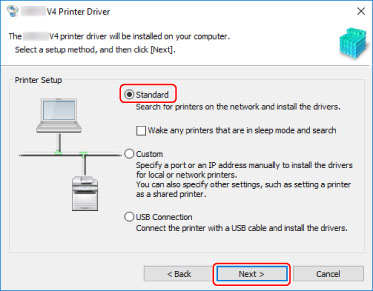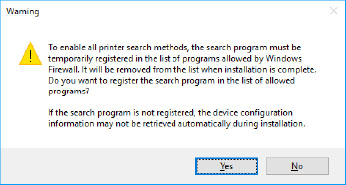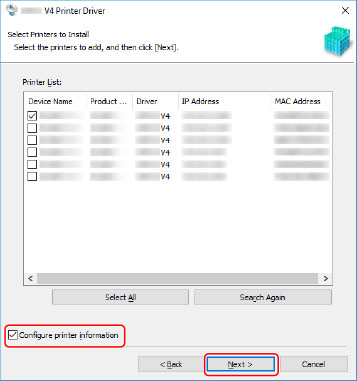Installing by Discovering Devices on a Network
You can automatically search for a device in a network environment and install the driver.
You can search for devices on TCP/IP networks and network environments that use WSD.
 NOTE
NOTEFor network environments other than the above, refer to the procedure for installing by specifying a port or IP address.
If you do not know the network environment you are using, check with your network administrator.
Prerequisites
Enabling [Use Multicast Discovery] at the device
For network environments that use WSD, enable [Use WSD Printing].
Setting the page description language selection (plug and play) function of the device
Set [PDL Selection (Plug and Play)] at the device to match the driver you are using. For details about the setting method, refer to the manual of the device.
The device is one that is on the same subnet as the computer you are using (for TCP/IP network environments)
When starting the computer, logon as a member of Administrators.
[Desktop] screen display (when using Windows 8.1/Server 2012 R2)
Procedures
1.
Double-click [Setup.exe].
2.
If you want to change the language displayed by the installer, select [Language] → click [Next].
The driver will be installed according to the selected language.
3.
Read the CANON SOFTWARE LICENSE AGREEMENT → click [Yes].
In the screen for checking the CANON SOFTWARE LICENSE AGREEMENT, if you click [Display Readme File], you can refer to the content of the Readme file.
4.
Select [Standard] → click [Next].
[Wake any printers that are in sleep mode and search]: Select this when you want to detect devices on the network that are in sleep mode.

5.
If the following screen is displayed, select [Add new printers] → click [Next].
[Add new printers and update existing printer drivers]: Select this when you want to update already installed drivers at the same time that you add a new driver.

6.
If the following message is displayed, confirm the message and click [Yes] or [No].
[Yes]: Communication using the TCP/IP protocol and WSD is enabled. This is normally recommended.
[No]: Communication is limited to the TCP/IP protocol only. In this case, device information may not be able to be retrieved correctly.

7.
Select the device to install from [Printer List].
If the device is not displayed in [Printer List], click [Search Again].
 NOTE
NOTEIf you cannot discover a device, there could be a problem with the operating system or device settings. Refer to the subsequent troubleshooting to enable the device to be displayed in the discovery results.
8.
If you want to change the name of the device, or set it as the default device, select [Configure printer information] → click [Next].
If you do not want to change the name of the device or set it as the default device, click [Next] and proceed to step 10.

9.
Change [Printer Name] → click [Next].
[Set as default]: Select this to set the device as the device that is normally used.
[Use as shared printer]: Select this if you want to share the device.
[Port]: Select the port you want to use if you can use multiple ports.

Check [List of Printers for Installation] → click [Start].
Proceed with the installation according to the instructions on the screen.
11.
Click [Exit].